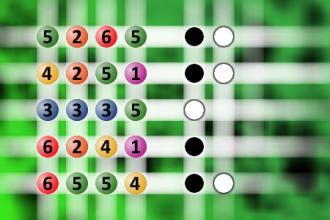What a winning combination?
The computer chose a secret code (sequence of 4 digits from 1 to 6). Your goal is to find that code. Black circles indicate the number of hits on the right spot. White circles indicate the number of hits on the wrong spot.Correct answers: 21
The first user who solved this task is Djordje Timotijevic.
#brainteasers #mastermind

A local lawyer was sitting in...
A local lawyer was sitting in his office the other morning when in walked a beautiful young lady. Without any preliminaries she said she wanted a divorce.
"On what grounds?" asked the lawyer.
"I don't think he is faithful to me," she replied.
"And what makes you think he isn't faithful?" asked the lawyer.
"Well," replied the young lady, "I don't think he is the father of my child."
"On what grounds?" asked the lawyer.
"I don't think he is faithful to me," she replied.
"And what makes you think he isn't faithful?" asked the lawyer.
"Well," replied the young lady, "I don't think he is the father of my child."

